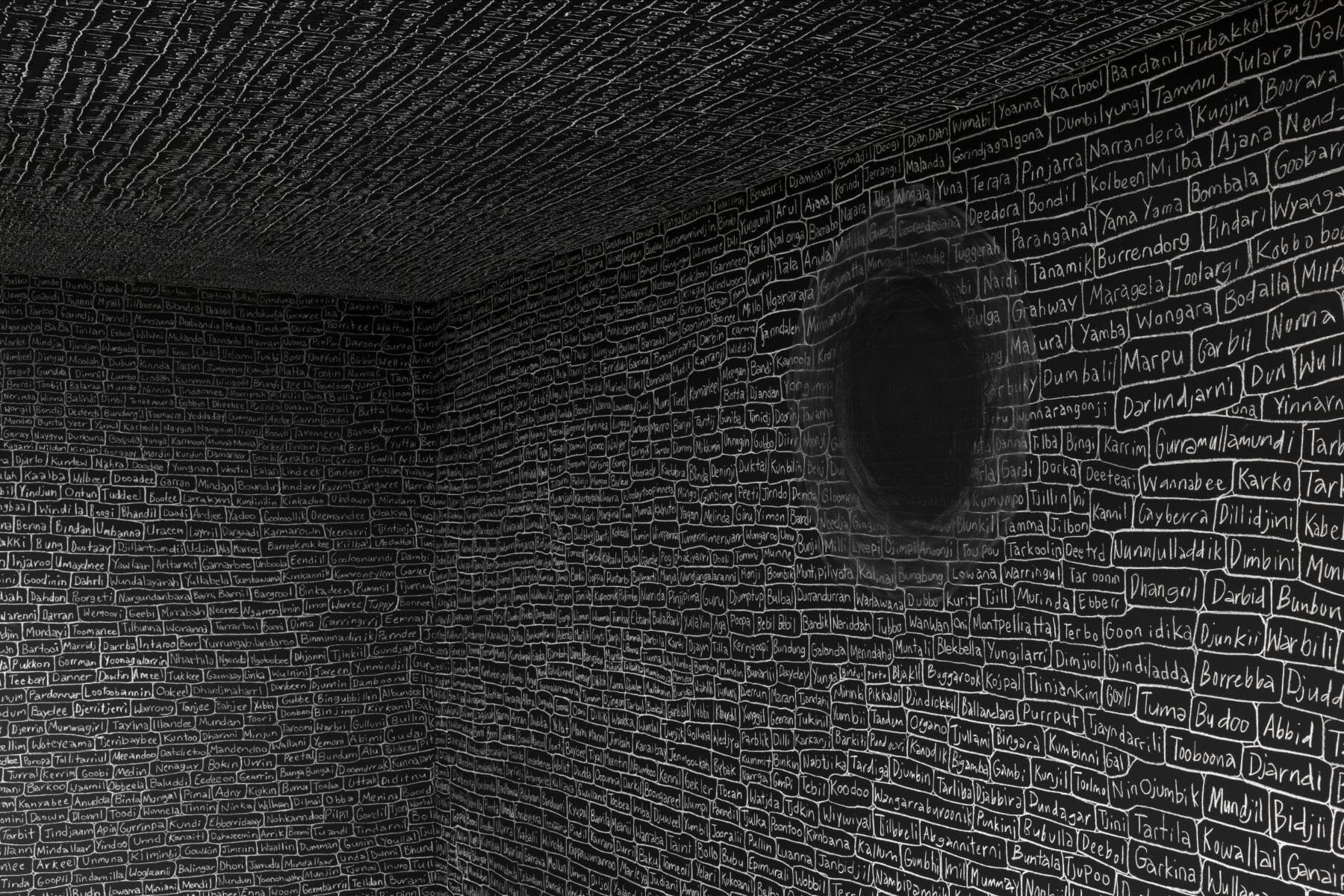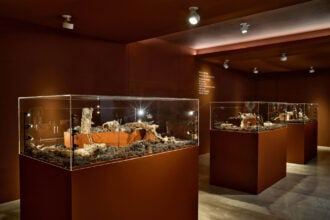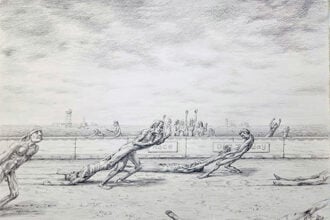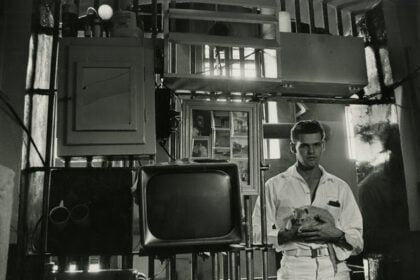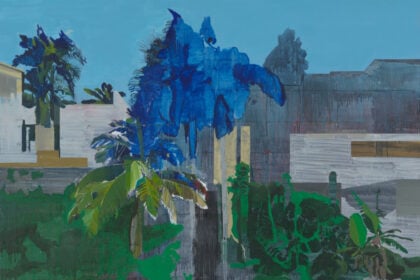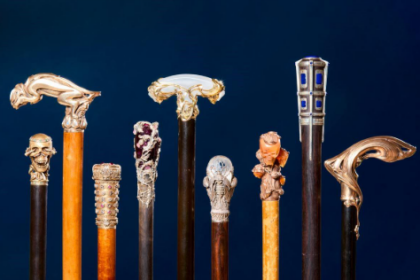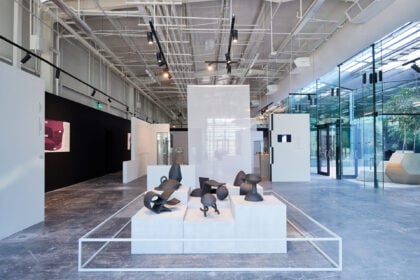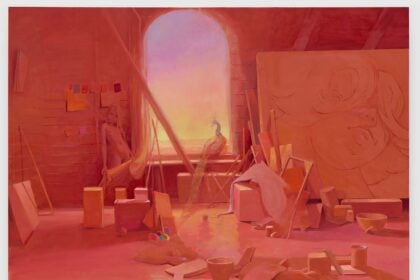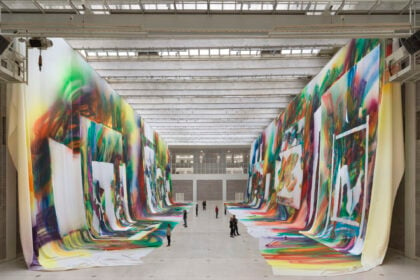- Archie Moore transforms the Australia Pavilion with a vast hand-drawn genealogical chart, his First Nations connections span more than 2,400 generations and 65,000 years.
- kith and kin confronts the ongoing legacies of Australia’s colonial history, with a focus on the overincarceration of First Nations peoples.
- Central to the presentation is a First Nations Australian understanding of time, in which past, present and future coexist.
- kith and kin represents the expansiveness of First Nations Australian history, whilst speaking to the universality of the human family.
kith and kin; an enveloping artwork created in situ by First Nations artist Archie Moore, premieres at the Australia Pavilion at the 60th International Art Exhibition – La Biennale di Venezia. Commissioned by Creative Australia, the exhibition is curated by Ellie Buttrose and is on view from 20 April – 24 November 2024.
In kith and kin, Moore transforms the Australia Pavilion with an expansive, genealogical chart spanning 65,000+ years. Drawing on his Kamilaroi, Bigambul, British and Scottish heritage, the installation embodies Moore’s enduring exploration of history and identity, central themes in his artistic practice spanning over 30 years. His work brings international awareness to the vitality of First Nations kinship, in spite of facing systemic injustices since British invasion in 1770. kith and kin provides audiences with the first significant opportunity to experience a solo exhibition of Moore’s art outside of Australia.
Hand-drawn in white chalk, the genealogical chart unfolds across the Pavilion’s five-metre-high black walls that run 60 meters in length, illustrating Moore’s lineage stretching back more than 2,400 generations. Derived from the artist’s research with family, community and archivists, this intricate map of relations reflects the unique familial structures of First Nations Australians that includes all living things and affirms their status as some of the longest-continuous living cultures in the world. Extending across the Pavilion’s black ceiling, the inscribed names resemble a celestial map; evoking the ancestors’ resting place. In the First Nations Australian understanding of time; the past, present and future are co-present. By placing tens of thousands of years of kin on a single continuum, Moore makes this notion visible to audiences.
The chart is also a stark representation of the decline in First Nations Australian languages and dialects under colonisation. Over 254 years the numbers have plummeted from as many as 700 to around 160, due to prohibitions on First language use, land dispossession and the killing of kin in colonial warfare. Countering this, Moore enacts language maintenance through his use of Gamilaraay (the Kamilaroi nation’s language) and Bigambul kinship terms. kith and kin illustrates the shift from Indigenous to European languages, the translation of oral languages to written text, and the introduction of racial categories and slurs. Moments of erasure amidst the names represent the atrocities inflicted upon First Nations communities, such as massacres, the introduction of diseases and destruction of knowledge that have all produced intergenerational trauma. In response, Moore’s choice of educational materials — fragile chalk on blackboard — addresses the insufficient dissemination of First Nations histories.
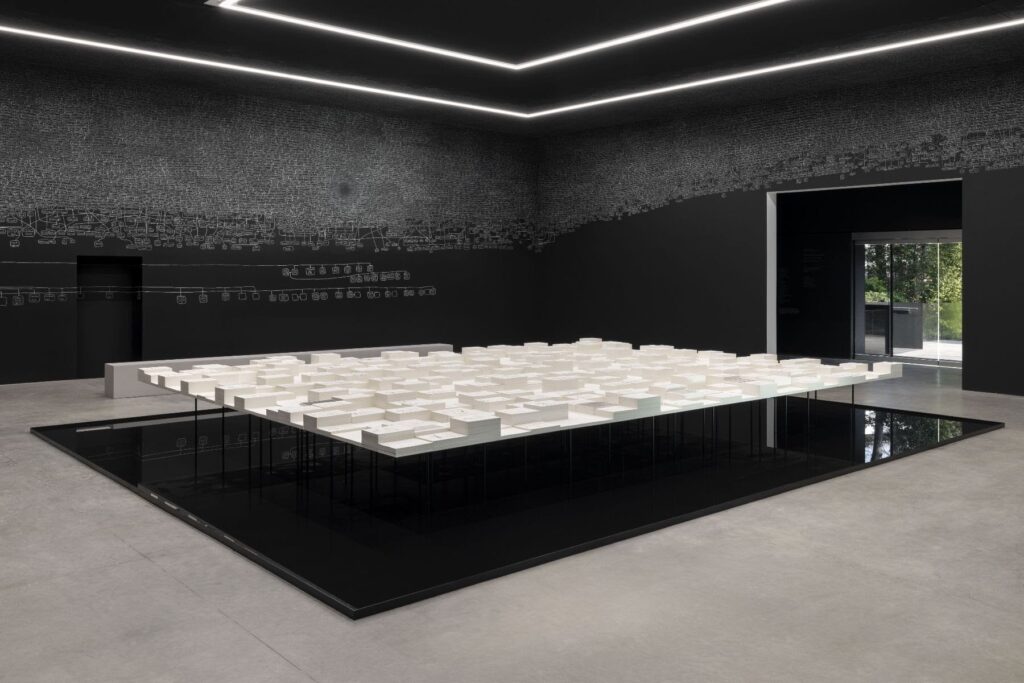
Photo credits: Archie Moore, kith and kin, 2024, Australia Pavilion at Venice Biennale 2024. Photographer: Andrea Rossetti. © The artist. Image courtesy of the artist and The Commercial.
A reflective pool, at the centre of the Pavilion, evokes the atmosphere of a memorial and pays tribute to the injustices still faced by First Nations peoples today. Suspended above it are more than 500 document stacks containing mainly coronial inquests on the deaths of Indigenous Australians in police custody dated in our lifetime. Despite First Nations Australians being just 3.8% of Australia’s population, they account for 33% of its prison population, making them among the most incarcerated people globally. Surrounded by the limitless family tree, viewers are reminded that the reports do not represent nameless statistics; rather, they are children, siblings, cousins, parents, uncles, aunts, grandparents and great-grandparents.
Moore’s artwork bridges the personal and the political. Amid the contemporary coroners’ reports are historic documents with specific references to the artist’s family. These include a court conviction from when Moore’s great uncle accidentally killed his father during a fight over their paltry wages; and reports by the Protector of Aboriginals denying Moore’s grandparents access to rights that non-Indigenous citizens enjoyed — such as freedom of movement. These bureaucratic papers evidence how pernicious laws and government policies have long been imposed upon First Nations peoples, emphasising the connection between the current incarceration epidemic and historic injustices. While many of the stories in kith and kin are specific to the artist’s family, they mirror narratives throughout the world. Through this lens Moore highlights our shared ancestry and humanity: through the interconnectedness of people, place and time.
Bringing together leading artists, curators, and writers on Thursday 18 April at Fondazione Querini Stampalia, ‘In discussion with kith and kin’ is a series of panel discussions that invite audiences to engage in greater depth with the themes that underpin Moore’s Australia Pavilion; First Nations language maintenance and art’s role in abolition movements. These conversations are presented by Creative Australia in partnership with ArtReview and Fondazione Querini Stampalia and feature: kith and kin artist Archie Moore and curator Ellie Buttrose; First Nations Australian writers Daniel Browning, Djon Mundine OAM, and Lorena Allam; curators of the Hãhãwpuá (Brazilian) Pavilion, Arissana Pataxó, Denilson Baniwa, and Gustavo Caboco Wapichana; artist Hank Willis Thomas; heather ahtone, Director of Curatorial Affairs, First Americans Museum; and Türkiye Pavilion artist Gülsün Karamustafa.
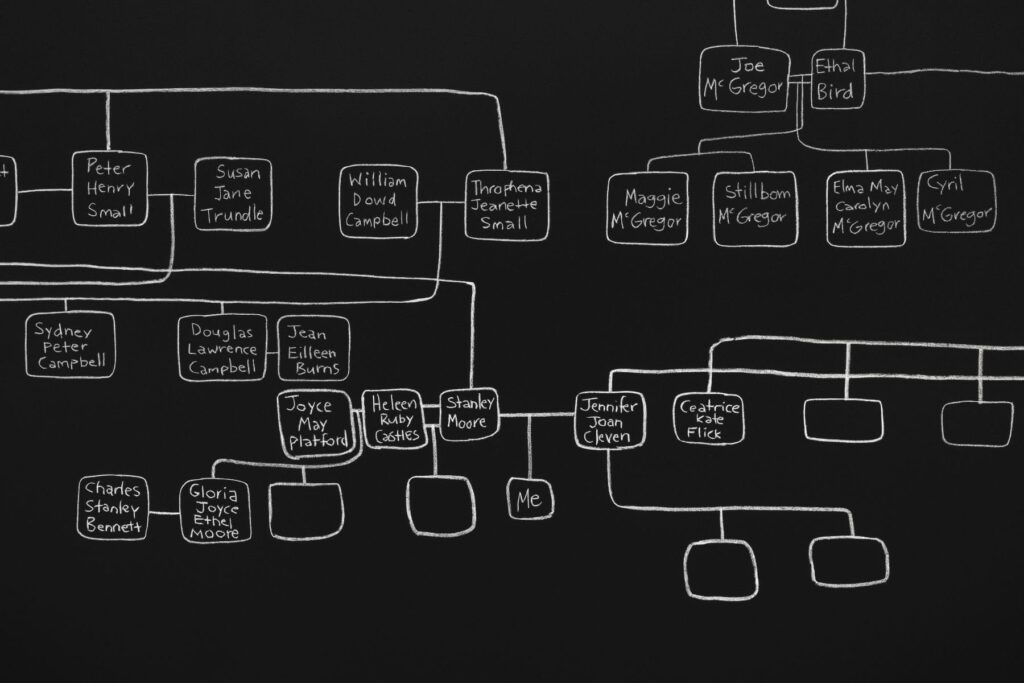
Photo credits: Archie Moore, kith and kin, 2024, Australia Pavilion at Venice Biennale 2024. Photographer: Andrea Rossetti. © The artist. Image courtesy of the artist and The Commercial.
Ellie Buttrose said: “The names of thousands upon thousands of Archie’s Kamilaroi and Bigambul forebears engulf the Australia Pavilion, declaring the artist’s sovereignty and that of his people. kith and kin reaches so far back into time that it includes the common ancestors of every human and all living entities — a timely reminder that we all have kinship responsibilities to one another. The simultaneity of past, present and future underpins the First Nations Australian understanding of time. By placing 65,000+ years of family on a single continuum, kith and kin immerses audiences in the co-presence of the ancestors and co-existence of time — by doing so Archie generously enfolds each of us into the everywhen.”
Creative Australia Executive Director First Nations Arts and Culture Franchesca Cubillo said:
“Archie Moore’s exhibition at the Australia Pavilion showcases the depth and resilience of First Nations arts and continuing culture. kith and kin offers profound insights into the interconnectedness of all peoples, underpinned by the rich tapestry of First Nations Australian culture. It is vital that these stories and the act of First Nations truth-telling can take place at such an important global platform. In this spirit, alongside the exhibition, there will be a program of talks expanding upon Archie Moore’s exhibition held in partnership with ArtReview at Fondazione Querini Stampalia. We hope these vital conversations led by First Nations Australian voices and internationally significant curators and artists increase global awareness and foster action for the issues facing First Nations Australians.”
Following the exhibition in the Australia Pavilion, the Queensland Art Gallery | Gallery of Modern Art (QAGOMA) plans to present kith and kin as part of its 2025-26 program.
The kith and kin exhibition has been developed by the artist and curator with exhibition design consultant Kevin O’Brien and exhibition digital designer Sebastian Adams.
The kith and kin publication features entries by the artist, sharing childhood memories of family, and acclaimed writer Melissa Lucashenko; along with new essays by distinguished curator and writer Djon Mundine OAM; Professor, legal expert, and writer Larissa Behrendt OA; Professor Macarena Gómez-Barris; and kith and kin curator Ellie Buttrose. The book includes a roundtable discussion with the artist, curator, Dhangatti and Gumbayngirr speaker and Indigenous language expert Doctor Raymond Kelly, linguistics Professor Felicity Meakins, anthropologist Emeritus Professor Diane Bell and Bundjalung editor Grace Lucas-Pennington. The graphic design work is by Stuart Geddes and Žiga Testen and it is edited by Archie Moore, Ellie Buttrose and Grace Lucas-Pennington.
The kith and kin website hosts videos discussing the exhibition and Moore’s wider practice that feature the artist, curator; curator and writer Djon Mundine OAM; Creative Australia Executive Director, First Nations Arts and Culture, Franchesca Cubillo; Professor, broadcaster, and writer, Larissa Behrendt AO; Director of the Guggenheim Abu Dhabi Project, Stephanie Rosenthal; and Senior Curator of Aboriginal and Torres Strait Islander Art at the National Gallery of Australia, Tina Baum. It also includes educational activities responding to the artwork conceived by Emma Hicks and Merindah Funnell and features Gamiliaraay translations by Donna Mclaren. The graphic design work is by Stuart Geddes and Žiga Testen with Jake Bonin.
